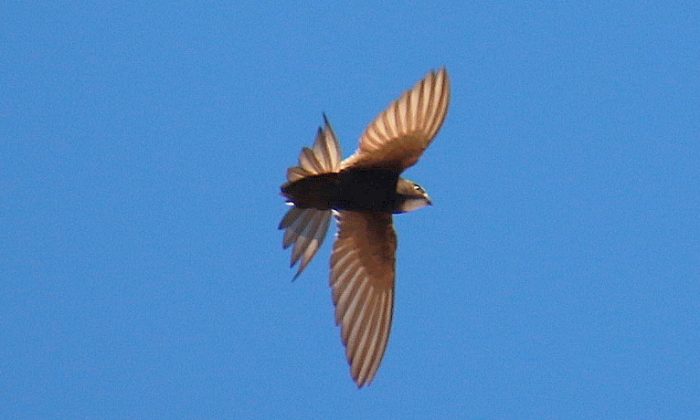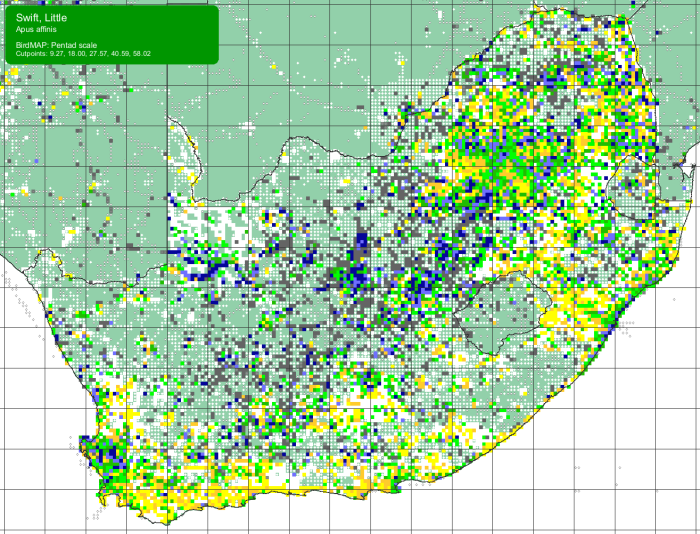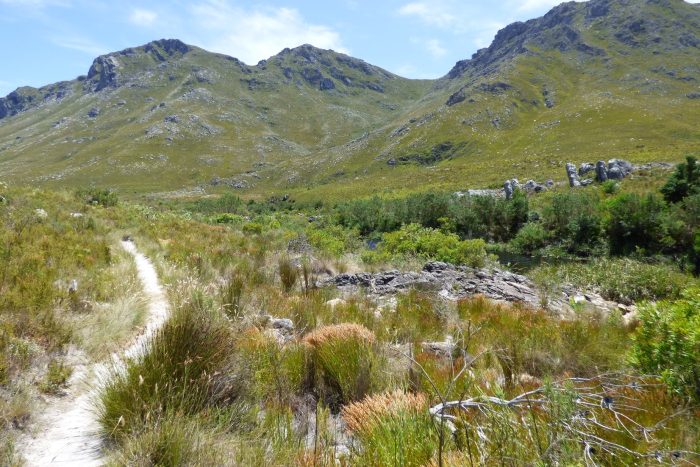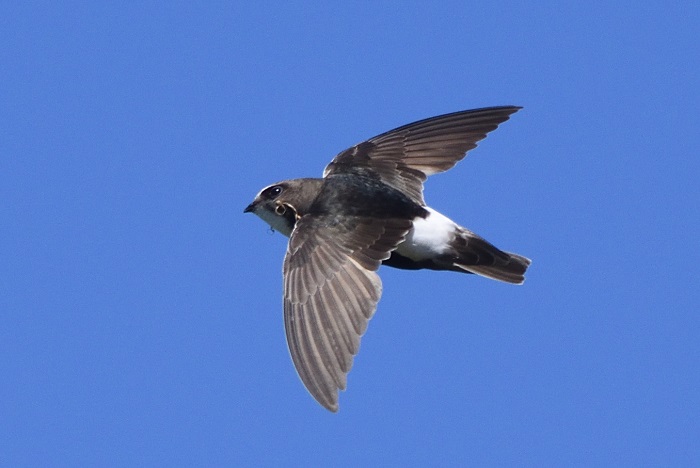Cover image: Little Swift by Gerald Wingate – Vanschoorsdrif, Western Cape – BirdPix No. 186019
Swifts are specialised, highly aerial birds with long pointed wings and short or deeply forked tails that provide superb manoeuvrability. They have very short legs and toes, and small bills with a wide gape to enable swallowing while in flight. Swifts and Spinetails belong to the family APODIDAE.
Identification

Carnarvon district, Northern Cape
Photo by Ryan Tippett
The Little Swift is a smallish species with a stocky build and a short, square tail that appears rounded when spread. The body is dark brownish-black, slightly darker and glossier on the mantle and back. It has a large, white throat patch and a distinctive, broad white rump that wraps around onto the flanks. This is often visible from below. The wings are dark brown to dull black with a silvery-grey hue. The bill is black while the feet are purplish-black and the eyes are dark brown.

St. Lucia, KwaZulu-Natal
Photo by Garth Aiston
The sexes are alike in plumage colouration. Juveniles are duller and browner than adults with pale-edged feathers.

Carnarvon district, Northern Cape
Photo by Ryan Tippett
The Little Swift is most similar to the Mottled Spinetail (Telacanthura ussheri), but the latter has distinctive short secondaries, bulging inner primaries and a white vent bar. White-rumped Swift (Apus caffer) and Horus Swift (Apus horus) have deeply to shallowly forked tails.

Walter Sisulu Botanical Gardens, Gauteng
Photo by Marius Meiring
Distribution and Status
The Little Swift is distributed throughout sub-Saharan Africa and the Indian sub-continent, with isolated populations in Morocco, the Arabian Peninsular, Iran and Turkmenistan. It occurs throughout southern Africa but is largely absent from the Namib Desert and the Kalahari (see habitat below).

The local range of the Little Swift has increased dramatically since 1900. It was historically confined to the dry western regions of southern Africa but is now common across the region. It originally nested on cliffs but has adapted to make extensive use of man-made buildings and other structures for breeding on. The Little Swift is now a common resident and partial migrant and is still expanding its local range and populations.

Vanschoorsdrif, Western Cape
Photo by Gerald Wingate
Habitat

Photo by Sharon Stanton
The Little Swift is most often seen near its breeding colonies around cliffs, gorges, rocky crags and in built up areas.
It forages in the air over all vegetation types including woodland and forest but prefers more open habitats like grasslands, Karoo scrub and fynbos. It occurs regularly over water and drinks frequently. The Little Swift is scarce or absent over much of the Namib and Kalahari, where its presence is limited by the availability of surface water for drinking.
Behaviour

Bird Island, Western Cape
Photo by Les Underhill
The little Swift is highly gregarious, often in flocks of hundreds of birds. It frequently forms mixed species foraging flocks with other swifts and occasionally with swallows.
It is mostly silent when feeding, but becomes very vocal in large flocks during ‘circus’ flight around roosting and nesting sites, especially in the late afternoon. In ‘Circus’ flight, large numbers of birds wheel and spiral together, calling incessantly. The purpose or function of this remains uncertain. Little Swifts roost in their nests or under the eaves of buildings.

Kruger National Park, Limpopo
Photo by Lappies Labuschagne
Typically flies at an almost constant height and speed, alternately fluttering and gliding slowly.
The Little Swift drinks regularly by skimming the water surface, with wings held high. They are insectivorous aerial specialists that feed on a wide array of flying insects such as termite alates, damselflies, dragonflies, mantids, katydids, grasshoppers, bugs, lacewings, antlions, beetles, flies, mosquitoes, wasps, ants, moths, butterflies and spiders.
They are attracted to termite alate emergences, foraging aerially and sometimes even on the ground. They also opportunistically follow fires to capture insects flushed by the flames. Little Swifts often forage at great heights, particularly in winter, and may travel up to 20km per day in search of food.

Gifberg, Western Cape
Photo by Salome Willemse
Breeds from September to May in southern Africa. The Little Swift is monogamous, and is usually a highly colonial nester but is known to sometimes nest solitarily. Nests are often found to be touching or overlapping. The nest is a closed bowl with a small side-top entrance. It is composed of grass and feathers and glued together with saliva. Nests are usually placed under an overhang or the eaves of buildings, bridges or a natural rock face.

Kruger National Park, Limpopo
Photo by J. Terblanche
1 to 3 elongate, white eggs are laid per clutch. The incubation period lasts from 17 to 23 days and incubation duties are shared by both sexes. The nestling period lasts for a further 40 days or so and the young are cared for by both sexes.

Britstown district, Northern Cape
Photo by Cathy Jenkins
Further Resources
This species text is adapted from the first Southern African Bird Atlas Project (SABAP1), 1997.
The use of photographs by Cathy Jenkins, Garth Aiston, Gerald Wingate, J. Terblanche, Lance Robinson, Lappies Labuschagne, Les Underhill, Marius Meiring, Salome Willemse and Sharon Stanton is acknowledged.
Virtual Museum (BirdPix > Search VM > By Scientific or Common Name).
Other common names: Kleinwindswael (Afrikaans); Nkonjana (Tswana); Huisgierzwaluw (Dutch); Martinet des maisons (French); Haussegler (German); Andorinhão-pequeno (Portuguese)
A list of bird species in this format is available here.
Recommended citation format: Tippett RM 2024. Little Swift Apus affinis. Biodiversity and Development Institute. Available Online at https://thebdi.org/2024/02/12/little-swift-apus-affinis/

Alberton district, Gauteng
Photo by Lance Robinson


why would the parents kick out the baby swift?